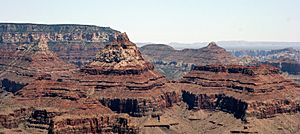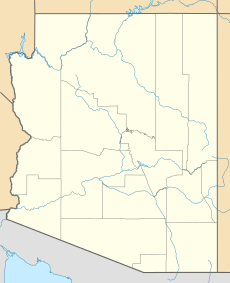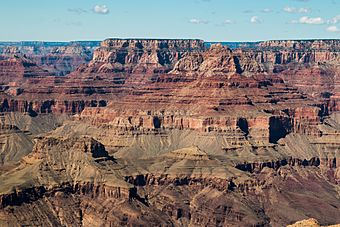Rama Shrine facts for kids
Quick facts for kids Rama Shrine |
|
|---|---|

Krishna, Vishnu, & Rama prominences
(Freya Castle at left rear) |
|
| Highest point | |
| Elevation | 6,406 ft (1,953 m) |
| Prominence | 706 ft (215 m) |
| Isolation | 0.98 mi (1.58 km) |
| Parent peak | Vishnu Temple |
| Geography | |
| Location | Grand Canyon National Park Coconino County, Arizona, US |
| Parent range | Kaibab Plateau (Walhalla Plateau) Colorado Plateau |
| Topo map | USGS Cape Royal |
| Geology | |
| Age of rock | Permian down to Mesoproterozoic-(east flank, northwest of Colorado River) |
| Mountain type | sedimentary rock: shale, sandstone,siltstone, mudstone, limestone, shale, basalt, silty-sandstone, sandstone |
| Type of rock | Hermit Shale-(prominence-debris) Supai Group-(unit 4, platform-Esplanade Sandstone), Supai Group, Redwall Limestone, Tonto Group-(3 units), 3_Muav Limestone, 2_Bright Angel Shale, 1_Tapeats Sandstone, Grand Canyon Supergroup-(4 units), 1-Unkar Group-(5-units), (unit 5)-Cardenas Basalt, (unit 4)-Dox Formation |
Rama Shrine is a tall rock formation in the eastern Grand Canyon. It stands about 6,406 feet (1,953 meters) high. This amazing natural landmark is found in Coconino County, in northern Arizona, United States.
The name "Rama Shrine" comes from Rama, a Hindu god known for being brave and good. This rock formation is connected to another large rock called Vishnu Temple, which is about 1 mile (1.6 km) away. Rama Shrine is also near the Cape Royal overlook, a popular viewing spot on the North Rim of the Grand Canyon. There's even a similar rock formation called the Krishna Shrine near Vishnu Temple. Rama Shrine rises about 4,000 feet (1,219 meters) above the Colorado River.
What is Rama Shrine Made Of?
The top part of Rama Shrine is a flat area made of a very hard rock called Esplanade Sandstone. This sandstone is part of a larger group of rocks known as the Supai Group. On top of this flat area, you can see pieces of reddish-brown rock called Hermit Shale. This shale is softer and often forms slopes.
How Rama Shrine Was Formed
Rama Shrine's geology is very similar to its neighbor, Vishnu Temple. The reddish-brown Hermit Shale is easy to spot on both formations. On Rama Shrine, this shale forms a thin layer of broken rock on top of the hard Esplanade Sandstone.
Below the Supai Group, you'll find a thick layer of Redwall Limestone. Underneath that are three older rock layers from the Cambrian period.
When you look at Rama Shrine from the southeast, especially from the South Rim, you can see it overlooking the Colorado River. You can also see wide areas of colorful hills and valleys made of very old rock called the Dox Formation. This rock formed during the Mesoproterozoic Era, which was a very long time ago. The lowest part of Rama Shrine shows the Tapeats Sandstone. This layer marks a huge gap in time, known as the Great Unconformity. It means that about 1,000 million years of rock layers are missing due to erosion before the Tapeats Sandstone was laid down.





